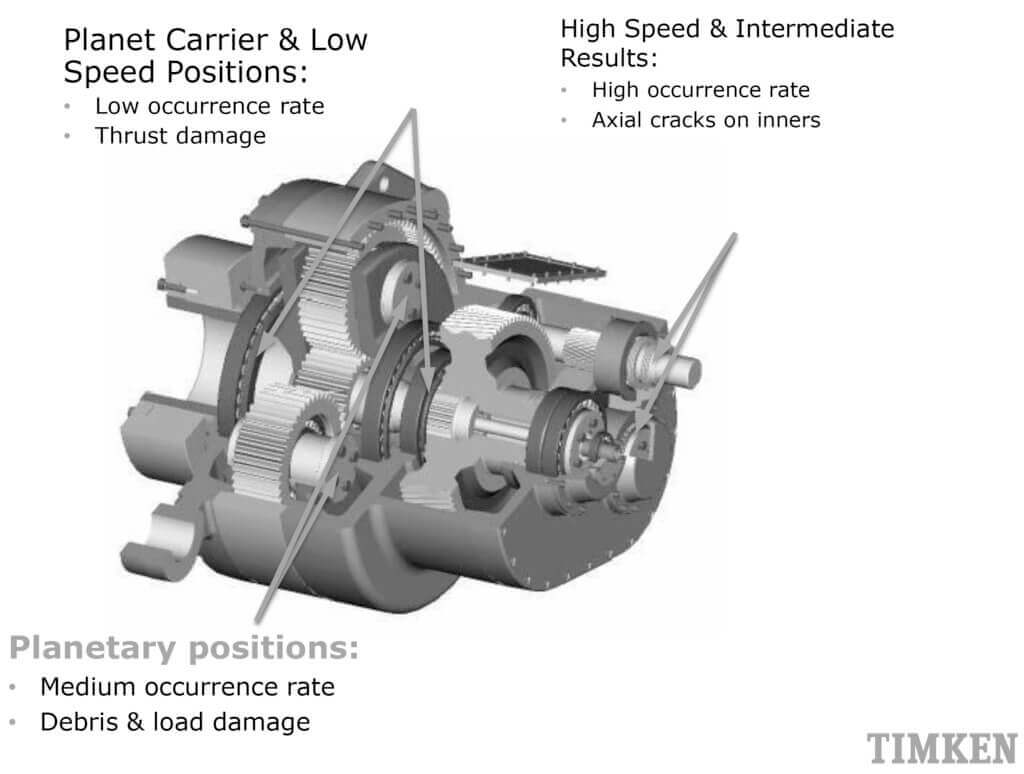By Michelle Froese | Senior editor
Windpower Engineering & Development

An integrated bearing reduces the total number of components in the assembly by directly machining bearing races into the surrounding components of a gearbox.
A bearing typically has three pieces: the rollers, an inner race that is pressed onto a shaft, and an outer race that is pressed into the gear bore. Exceptional engineering and quality components are important if the gearbox is to endure the harsh and variable conditions inside an operating wind turbine. A gearbox bearing will also require proper lubrication and regular condition monitoring to ensure optimal performance.
However, even with a top-notch O&M strategy, bearing failure rates typically occur every 5 to 10 years depending on the type and position — which eats into most turbine’s 20-year life expectancy. High-speed bearing failures occur more frequently, but planet-carrier and low-speed bearing failures are more costly.
“Damage to a planetary bearing can accumulate quickly,” explains Richard Brooks, Manager of the Wind Energy Aftermarket at The Timken Company. “And unlike high-speed bearings, replacing a planetary bearing requires a more complex strategy than simply sending a couple wind techs up tower for repairs. Typically a crane is needed on site, and potentially a full rebuild of the gearbox.”
To address the problem, the wind industry is working to better understand and mitigate failures and avoid costly repair services. One way is to repair the gearbox without removing it, in the nacelle. “A few years back if you had a planet bearing problem, that gearbox had to be removed from the nacelle and tower, which always required a crane,” says Brooks. “Service companies have gotten creative and figured out ways to replace planetary bearings up tower when possible. This delivers cost savings.”
Another way bearing manufacturers are working to reduce failures is by redesigning the bearing and combining a few components. This design idea might use the shaft as a bearing’s inner race or machine the outer race into the gear’s bore, or both.
“The integration work essentially machines the bearing’s outer race into the inner bore of the gear,” explains Brooks. An integrated bearing reduces the total number of components in the assembly by directly machining bearing races into the surrounding components of a gearbox. It is an option for cylindrical and tapered gearbox planet bearings.

Bearings serve numerous roles in a wind-turbine gearbox and show different failure rates based on their position.
“In some ways it brings complexity into the manufacturing process because bearings are not made at gear plants nor are gears made at bearing plants,” he points out. “But there are a lot of advantages to integrating the two.”
Most notably: integrated bearings show improved performance and greater power density. “Certain failure modes simply don’t exist with the integrated design,” he says. “One example is referred to as a creeping outer. This occurs when a bearing race is pressed into the gear so that, over time and under load, the bearing can potentially move and generate debris. Of course you don’t want that, and it cannot occur with a one-piece, integrated component.
For this reason, many brand-new gearbox designs are employing integrated bearings, whether cylindrical or tapered.
“It takes time, but with each new design we progress and gain more knowledge,” says Brooks. “In fact, a few companies are also starting to offer integrated retrofit rebuilds, which is a fairly new and exciting option in the wind industry.”
Filed Under: Bearings, News




